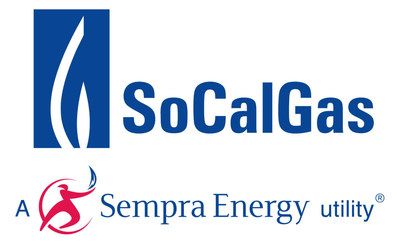LOS ANGELES, April 11, 2019 /PRNewswire/ -- Southern California Gas Co. (SoCalGas) today announced the California Energy Commission (CEC) has awarded the company a $3 million grant to fund the next phase of development of a new technology that doubles the amount of renewable energy created from the decomposition of organic material at wastewater treatment plants. The new process, known as Hydrothermal Processing (HTP), reduces greenhouse gas emissions by three times that of traditional anaerobic digestion and costs about half. HTP is highly efficient, using heat and pressure to capture 86 percent of the energy in the waste and using only 14 percent to process it. A pilot project, to be located at the Central Contra Costa Sanitary District ("Central San") Wastewater Treatment Plant in Martinez, California. The work is being funded in part by the California Energy Commission, SoCalGas and other private participants.
"Technological advances, like hydrothermal processing, are an important part of SoCalGas' vision to be the cleanest natural gas utility in North America and will help us meet our commitment of to deliver renewable natural gas to homes and businesses," said Ron Kent, Technology Development Manager at SoCalGas. "This new technology holds the potential to convert not only wastewater, but landfill, forestry and food waste into carbon-neutral renewable energy that displaces fossil fuels and helps California meet its climate goals."
"The best thing about HTP is how simple it is," said Corinne Drennan, who is responsible for bioenergy technologies research at the Department of Energy's Pacific Northwest National Laboratory. "The reactor is literally a hot, pressurized tube. We've really accelerated hydrothermal conversion technology over the last seven years to create a continuous, and scalable process which allows the use of wet wastes like sewage sludge without the need for drying it first. And we're excited to see HTP piloted beyond the lab, at an actual waste treatment plant."
"The project will lay the groundwork for full-scale commercial hydrothermal processing plants that could revolutionize the way renewable energy is produced at wastewater treatment plants," said James Oyler, president of Genifuel Corporation, which produces the HTP equipment patented by PNNL. "Unlike anaerobic digestion, this technology completely eliminates leftover biosolids. Getting rid of the biosolids hauled to landfills would significantly reduce costs for wastewater treatment facilities."
The project team is comprised of a number of industry leaders, including: SoCalGas, the Water Research Foundation, Central San, PNNL, Genifuel Corporation, Merrick & Company, Black & Veatch, Brown and Caldwell, MicroBio Engineering, Leidos, and others.
Earlier this month, SoCalGas announced a broad, inclusive and integrated plan to help achieve California's ambitious environmental goals in a paper titled California's Clean Energy Future: Imagine the Possibilities. The plan embraces an all-of-the-above approach to fight climate change, keeps energy affordability as a key focus, calls for developing long-term renewable energy storage using existing infrastructure, and can aid in promoting rapid consumer adoption. The new strategy comes one month after SoCalGas announced its vision to be the cleanest natural gas utility in North America, delivering affordable and increasingly renewable energy to its customers.
As part of that vision, SoCalGas committed to replace 20 percent of its traditional natural gas supply with renewable natural gas (RNG) by 2030. Research shows that replacing about 20 percent of California's traditional natural gas supply with RNG would lower emissions equal to retrofitting every building in the state to run on electric only energy and at a fraction of the cost. Using RNG in buildings can be two to three times less expensive than any all-electric strategy and does not require families or businesses to purchase new appliances or take on costly construction projects.
In California, scientists at the University of California, Davis estimate that the state's existing organic waste could produce enough RNG to meet the needs of 2.3 million homes.
About SoCalGas
Headquartered in Los Angeles, SoCalGas® is the largest natural gas distribution utility in the United States. SoCalGas delivers affordable, reliable, clean and increasingly renewable natural gas service to 21.8 million customers across 24,000 square miles of Central and Southern California, where more than 90 percent of residents use natural gas for heating, hot water, cooking, drying clothes or other uses. Natural gas delivered through the company's pipelines also plays a key role in providing electricity to Californians — about 45 percent of electric power generated in the state comes from gas-fired power plants.
SoCalGas' vision is to be the cleanest natural gas utility in North America, delivering affordable and increasingly renewable energy to its customers. In support of that vision, SoCalGas is committed to replacing 20 percent of its traditional natural gas supply with renewable natural gas (RNG) by 2030. Renewable natural gas is made from waste created by dairy farms, landfills and wastewater treatment plants. SoCalGas is also committed to investing in its natural gas system infrastructure while keeping bills affordable for our customers. From 2014 through 2018, the company invested nearly $6.5 billion to upgrade and modernize its natural gas system to enhance safety and reliability. SoCalGas is a subsidiary of Sempra Energy (NYSE: SRE), an energy services holding company based in San Diego. For more information visit socalgas.com/newsroom or connect with SoCalGas on Twitter (@SoCalGas), Instagram (@SoCalGas) and Facebook.

SOURCE Southern California Gas Company
